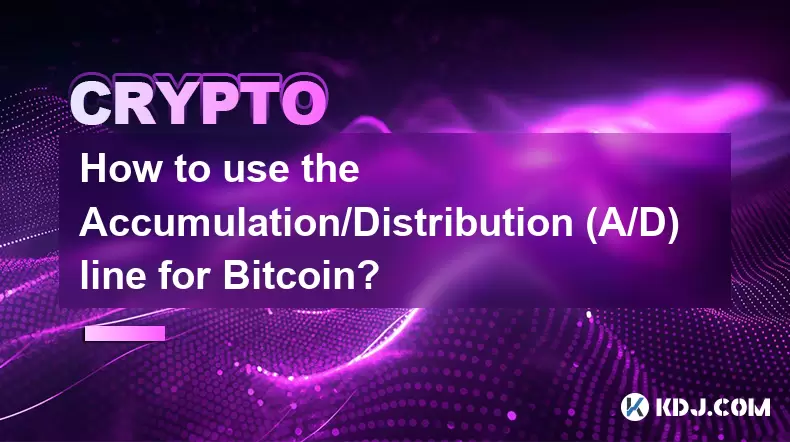-
 bitcoin
bitcoin $122025.899241 USD
-2.12% -
 ethereum
ethereum $4488.068729 USD
-4.11% -
 bnb
bnb $1315.348019 USD
8.65% -
 tether
tether $1.000457 USD
0.03% -
 xrp
xrp $2.875326 USD
-3.69% -
 solana
solana $222.043604 USD
-4.07% -
 usd-coin
usd-coin $0.999682 USD
0.00% -
 dogecoin
dogecoin $0.249887 USD
-5.62% -
 tron
tron $0.337379 USD
-2.59% -
 cardano
cardano $0.827763 USD
-5.06% -
 hyperliquid
hyperliquid $45.774531 USD
-2.43% -
 chainlink
chainlink $22.079309 USD
-5.87% -
 ethena-usde
ethena-usde $1.000156 USD
0.02% -
 sui
sui $3.482566 USD
-3.57% -
 stellar
stellar $0.386982 USD
-4.92%
How to use the Accumulation/Distribution (A/D) line for Bitcoin?
The Accumulation/Distribution line helps Bitcoin traders gauge buying or selling pressure by combining price and volume data, signaling potential trend reversals or continuations.
Jul 07, 2025 at 10:15 am

Understanding the Accumulation/Distribution Line in Cryptocurrency Trading
The Accumulation/Distribution (A/D) line is a technical analysis tool used to measure the buying and selling pressure of an asset. In the context of Bitcoin, this indicator helps traders understand whether the cryptocurrency is being accumulated or distributed by market participants, which can signal potential trend reversals or confirm ongoing trends.
Unlike simple volume indicators, the A/D line incorporates both price and volume data to provide a more nuanced view of market dynamics. This makes it particularly useful in the volatile world of Bitcoin trading, where sudden shifts in sentiment can drastically affect price movements.
How the A/D Line is Calculated for Bitcoin
To effectively use the A/D line for Bitcoin, it’s essential to understand its calculation mechanics. The formula involves several steps:
First, determine the Money Flow Multiplier, which is calculated as:
$$ \text{Money Flow Multiplier} = \frac{(Close - Low) - (High - Close)}{High - Low} $$
Next, calculate the Money Flow Volume by multiplying the Money Flow Multiplier by the volume: $$
\text{Money Flow Volume} = \text{Money Flow Multiplier} \times \text{Volume}$$
Finally, the A/D line value is derived by cumulatively adding the Money Flow Volume over time:
$$ \text{A/D Line} = \text{Previous A/D Value} + \text{Current Money Flow Volume} $$
This cumulative approach allows the A/D line to reflect how buying and selling pressure evolves across different timeframes, especially when applied to high-volume assets like Bitcoin.
Interpreting the A/D Line for Bitcoin Price Movements
When analyzing Bitcoin's price chart, traders often look for divergences between the A/D line and price action. These divergences can be powerful signals:
- If Bitcoin’s price is rising but the A/D line is falling, it suggests that despite higher prices, there may not be strong buying support—this could indicate an upcoming reversal.
- Conversely, if Bitcoin’s price is falling but the A/D line is rising, it implies that accumulation is happening at lower levels, potentially signaling a bullish reversal.
It's also crucial to observe the slope of the A/D line. A steep upward slope indicates strong accumulation, while a flattening or downward slope may suggest distribution or weakening demand.
Using the A/D Line in Conjunction with Other Indicators
While the A/D line is valuable on its own, combining it with other tools enhances its effectiveness, especially in the fast-moving Bitcoin market:
- Pairing the A/D line with moving averages can help identify stronger entry and exit points. For instance, when the A/D line crosses above its moving average and Bitcoin's price breaks out, it could signal a strong uptrend.
- Using volume profile alongside the A/D line can reveal key support and resistance levels where significant accumulation or distribution occurs.
- Overlaying the A/D line with on-balance volume (OBV) provides cross-verification of institutional activity in the Bitcoin market.
These combinations allow traders to filter out false signals and focus on high-probability setups.
Practical Steps to Apply the A/D Line on Bitcoin Charts
Applying the A/D line to Bitcoin charts requires attention to detail and proper platform settings:
- Open your preferred trading platform such as TradingView or Binance and load the Bitcoin chart.
- Navigate to the indicators section and search for “Accumulation/Distribution”.
- Add the indicator to the chart and ensure it appears below the main price window.
- Customize the settings if needed; most platforms use default values suitable for daily or hourly charts.
- Observe how the A/D line behaves relative to Bitcoin’s price, paying close attention to divergence patterns.
For best results, apply the A/D line on multiple timeframes—such as 1-hour, 4-hour, and daily charts—to get a comprehensive understanding of short-term and long-term accumulation/distribution behavior.
Frequently Asked Questions
Q: Can the A/D line be used for altcoins as well? Yes, the A/D line is applicable to all cryptocurrencies, including altcoins. However, due to lower liquidity and volume compared to Bitcoin, interpretation should be done cautiously and ideally with additional confirmation tools.
Q: Does the A/D line work during sideways markets? In ranging or sideways markets, the A/D line can still provide insights into accumulation or distribution zones. Traders should watch for breakouts from these ranges supported by A/D line momentum.
Q: How does the A/D line differ from On-Balance Volume (OBV)? While both are volume-based indicators, the A/D line considers the location of the close within the period’s range, whereas OBV simply adds or subtracts volume based on whether the close is higher or lower than the previous close. This makes the A/D line more sensitive to intraday price action.
Q: Is the A/D line reliable on smaller timeframes like 5-minute or 15-minute charts? The A/D line can generate many false signals on very small timeframes due to increased noise and volatility. It's generally more effective on hourly or daily charts for assets like Bitcoin where volume is substantial and meaningful.
Disclaimer:info@kdj.com
The information provided is not trading advice. kdj.com does not assume any responsibility for any investments made based on the information provided in this article. Cryptocurrencies are highly volatile and it is highly recommended that you invest with caution after thorough research!
If you believe that the content used on this website infringes your copyright, please contact us immediately (info@kdj.com) and we will delete it promptly.
- BlockDAG, DOGE, HYPE Sponsorship: Crypto Trends Shaping 2025
- 2025-10-01 00:25:13
- Deutsche Börse and Circle: A StableCoin Adoption Powerhouse in Europe
- 2025-10-01 00:25:13
- BlockDAG's Presale Buzz: Is It the Crypto to Watch in October 2025?
- 2025-10-01 00:30:13
- Bitcoin, Crypto, and IQ: When Genius Meets Digital Gold?
- 2025-10-01 00:30:13
- Stablecoins, American Innovation, and Wallet Tokens: The Next Frontier
- 2025-10-01 00:35:12
- NBU, Coins, and Crypto in Ukraine: A New Yorker's Take
- 2025-10-01 00:45:14
Related knowledge

Why is Bitcoin considered a revolutionary technology?
Aug 12,2025 at 08:29pm
Decentralization and the Elimination of Central AuthoritiesThe core innovation behind Bitcoin lies in its decentralized architecture, which fundamenta...

Why is Bitcoin considered a revolutionary technology?
Aug 10,2025 at 07:42pm
Decentralized Architecture and Trustless TransactionsBitcoin is considered revolutionary because it introduced a decentralized architecture that opera...

What are the key features of Bitcoin?
Aug 10,2025 at 02:50am
Decentralization and Peer-to-Peer NetworkOne of the most defining characteristics of Bitcoin is its decentralized nature. Unlike traditional financial...

Can the Bitcoin protocol be changed?
Aug 07,2025 at 01:16pm
Understanding the Bitcoin ProtocolThe Bitcoin protocol is the foundational set of rules that govern how the Bitcoin network operates. It defines every...

Can the Bitcoin protocol be changed?
Aug 11,2025 at 01:01am
Understanding the Bitcoin Protocol StructureThe Bitcoin protocol is the foundational set of rules that govern how the Bitcoin network operates. These ...

What happens to Bitcoin transactions once they are confirmed?
Aug 09,2025 at 05:22am
Understanding Bitcoin Transaction ConfirmationWhen a Bitcoin transaction is initiated, it is broadcast to the network and placed in a pool of unconfir...

Why is Bitcoin considered a revolutionary technology?
Aug 12,2025 at 08:29pm
Decentralization and the Elimination of Central AuthoritiesThe core innovation behind Bitcoin lies in its decentralized architecture, which fundamenta...

Why is Bitcoin considered a revolutionary technology?
Aug 10,2025 at 07:42pm
Decentralized Architecture and Trustless TransactionsBitcoin is considered revolutionary because it introduced a decentralized architecture that opera...

What are the key features of Bitcoin?
Aug 10,2025 at 02:50am
Decentralization and Peer-to-Peer NetworkOne of the most defining characteristics of Bitcoin is its decentralized nature. Unlike traditional financial...

Can the Bitcoin protocol be changed?
Aug 07,2025 at 01:16pm
Understanding the Bitcoin ProtocolThe Bitcoin protocol is the foundational set of rules that govern how the Bitcoin network operates. It defines every...

Can the Bitcoin protocol be changed?
Aug 11,2025 at 01:01am
Understanding the Bitcoin Protocol StructureThe Bitcoin protocol is the foundational set of rules that govern how the Bitcoin network operates. These ...

What happens to Bitcoin transactions once they are confirmed?
Aug 09,2025 at 05:22am
Understanding Bitcoin Transaction ConfirmationWhen a Bitcoin transaction is initiated, it is broadcast to the network and placed in a pool of unconfir...
See all articles










































































